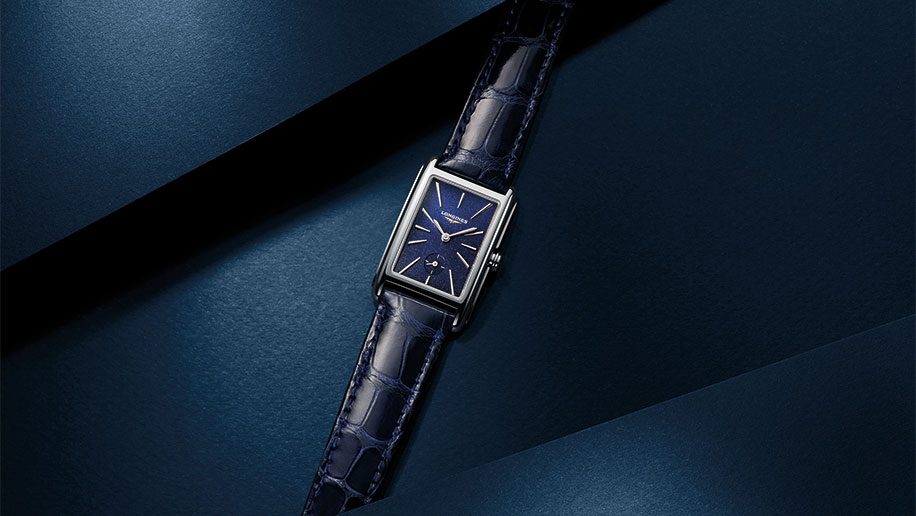
More commonly marketed to women, are we about to see a resurgence of square watches for men? If so then Longines is ahead of the curve, writes Chris Hall
When you think about it, there are plenty of logical reasons for a watch to be round. The mechanics inside a movement operate in circles, from the unwinding mainspring that drives the watch to the wheels and gears that translate that energy into regular, controlled motion. It’s easiest to read the time on a circular dial, with every point equidistant from the centre, and at a deeper, more fundamental level, the building blocks of our system of measuring time are all approximately circular: the rotation of the earth on its axis around the sun, and that of the moon around the earth.
There are other practical reasons, too – as watches were developed in the 1930s and ’40s to be more durable and hard-wearing, round cases found favour partly because they were easier to water-proof, usually by screwing the back into the circular case, and when watches capable of surviving hundreds of metres underwater were required, round cases were better able to deal with the pressure.
Around 80 per cent of watches sold are round, which bears out its common-sense appeal. But what of the other 20 per cent? The first purpose-built wristwatches were square, or more typically rectangular (starting with the Cartier Santos-Dumont in 1904) and have retained their allure for more than a century. Look at the cult appeal of a Jaeger-LeCoultre Reverso or a Tag Heuer Monaco: both celebrated designs with well-known watch-geek stories – the Reverso for its arcane, flippable case developed for polo players, and the Monaco for its association with actor Steve McQueen and as the first square shape watch to be water-resistant.
More generally, however, square watches have been marketed more assiduously to women, often in diminutive cases powered by quartz movements. Look across the market, from Patek Philippe to Hermes, and that’s what you’ll find. Until this year, that was also true for Longines’ Dolce Vita, which was first launched in 1997, but now the Swiss brand has added a larger case size to the range for the first time, and intends to position the Dolce Vita “XL” (£1,050) as a men’s watch. It has got an automatic movement, which is a key point because it appeals to a male audience.
Going mainstream
It does make one wonder whether we are due a resurgence for “mainstream” square watches aimed at men – that is to say, models that sell themselves purely on their shape and design, rather than with the assistance of a butch narrative about motorsports or aviation (as is the case with Bell and Ross’s square-cased pilot’s watches, for instance).
For one thing, we are reaching the centenary of the art deco movement that so heavily influenced many of the first generation of wristwatches: look at the Dolce Vita’s case, with one long line from end to end and the parallel extruded sections on each side. Look at the elegant, thin hour markers, and the contrast between their silvered finish and the deep blue dial, glittering like a starry night. This is a watch plucked straight from one of Jay Gatsby’s parties. As our art and culture look to recapture the spirit of the roaring twenties, I expect demand for this kind of watch to increase.
Traditionally, men are steered towards square watches for black tie functions and formal events, for the geometric harmony between watch case and shirt cuff, and that’s definitely the best place for this Dolce Vita, but in time, other less flamboyant dial designs will follow that will be better suited to everyday wear.
The other reason I think oblong shapes might now be getting more of a look-in on our wrists is firmly rooted in the present day. I’ll grant that the jury is still out over the long-term influence of the Apple watch on the traditional watch industry (it seems conclusive that it has dealt a blow to sub-£500 offerings, but whether today’s young Apple customers will “graduate” into mechanical watches over time, as many predict, is yet to be seen). Still, I think the tech giant’s decision to use a rectangular watch shape could yet be significant.
It was interesting to note that when Switzerland’s brands attempted to respond to the rise of the smartwatch – think Tag Heuer’s Connected or Montblanc’s Summit – they did so in the form of round watches. Circular timepieces may be the most logical shape for timekeeping, but they are fundamentally compromised in the age of the screen; now that rectangles are the dominant form factor for conveying information, is it too much of a stretch to think that that might have an influence when we go shopping for old-fashioned watches?












